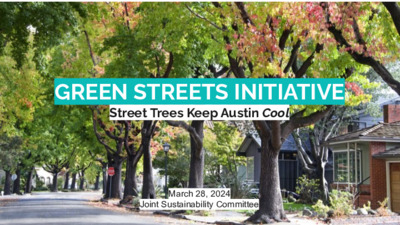Great streets initiative - presentation — original pdf
Backup

GREEN STREETS INITIATIVE Street Trees Keep Austin Cool March 28, 2024 Joint Sustainability Committee We Need Street Trees: STREETS ARE HOT & DANGEROUS ● Austin is warm and getting warmer - By 2050, Austin is estimated to experience an average of ~3 months per year (82-95 days) with a heat index over 100° compared to ~1 month” historically (29 days) ● It is even hotter in the Streets - Unshaded streets become “urban heat islands”, absorbing and reflecting the sun’s heat, causing streets to be 5-10° hotter than other parts of the city. ● Our streets are dangerous - 2022 was the deadliest year on Austin roads topping the previous record set in 2021. We Need Street Trees: IMPACTS & ACCESS ARE INEQUITABLE ● Low-income and BIPOC communities in Austin are disproportionately impacted by dangerous streets and extreme heat ● Tree canopy is inevitably distributed Austin, TX - Pedestrian incidents per 100,000 (2019-2022) Source: Austin Vision Zero via Urbinden Design Lab * Approximation- Available data misaligned. Incidents by race from 5 year avg. (2017-2022), total pop. from 2020 census, pedestrian incidents averaged 4 year avg. (2019-2022) We Need Street Trees: STREET TREES MAKE OUR STREETS COOLER & SAFER ● Street trees shade create microclimates on our sidewalks and bikeways with shade and evapotranspiration ● Street trees slow vehicle speeds and reduce the frequency and severity of crashes. Source: Urbinden Design Lab Barriers: REGULATIONS ● Private development is only required to provide street trees on ~3.3% of the streets in Austin. Incentivized ~1.1% ● Where street trees are required, it is easier to get relief from the requirement than to comply ● TCM street tree requirements are NOT regulatory - NOT enforced (required on level 2 and up) 3.3% 1.1% * 95.6% * Some PUDs may include street trees requirements (example: Mueller). PUDs represent ~8% of the City of Austin Barriers: ADMINISTRATIVE RULES ● Criteria Manual rules protect departmental interests, do not optimize limited ROWs, do not understand how trees grow ● Some rules conflict with City goals, policies, and priorities, often superseding adopted regulations ● Inflated rules trigger case-by-case departmental review of street trees - reducing predictability and often prohibiting street trees Interpretation of existing code Urban condition best practice Barriers: PROCEDURES ● Street trees require license agreement to privatize maintenance responsibility ● License agreement process is duplicative of site plan review ○ Adds time - upto 2 years ○ Adds risk- inconsistent interpretations can jeopardize approved site ● Most development consultant teams pursue AEC or waivers instead of plans planting street trees Standard comment from site plan review Barriers: COST ● Permitting street trees is very unpredictable, risky, and expensive ● Moving utilities is expensive ● Properly installed street trees are not cheap to plant and require ongoing irrigation and maintenance ● Some projects like affordable housing are particularly sensitive to cost increases Barriers: LEADERSHIP ● Departmental silos limit holistic solutions ● There is no single person or group with the authority and responsibility to: ○ Ensure that ROWs are optimized to achieve City goals and policies ○ Marshal various ROW stakeholder interests to implement legacy projects ○ Guide long-term planning to comprehensively implement a shared vision for our streets. Mayor’s Office to coordinate and facilitate high-quality, public space projects. In 2023, NYC created a Public Realm Officer post in the Solutions: GREEN STREETS INITIATIVE 1. 2. 3. [Process] Eliminate the License Agreement requirement for street trees. [Regulations] Require street trees on all streets for both private and public projects. [Rules] Reform criteria manual rules to eliminate barriers to planting street trees, including reducing physical separation standards between trees and utilities and restricting utilities within the planting zone. Solutions: GREEN STREETS INITIATIVE 4. [Standardization] Adopt new street tree standard details, specifications and product lists that: ○ Define street trees and related equipment as standard items in the public ROW without requiring a case-by-case departmental review, ○ Provide sufficient soil volume and quality for street trees, ○ Provide necessary protections for utilities in close proximity to street trees, including root barriers. Use the Corridor Construction Program Tree Manual details and specifications as a starting point. Solutions: GREEN STREETS INITIATIVE 5. 6. [Funding] Identify funding to subsidize street tree planting for SMART Housing projects, ETOD projects, public projects along transit corridors, and to pay for street tree replacement for utility maintenance projects. [Leadership] Appoint an assistant city manager-level “Public Realm Officer” to help guide the above efforts who has the final authority to resolve conflicts between different ROW stakeholders. In the planning, development review and implementation process of both public and private projects, while ensuring alignment of rules and regulations with adopted city plans and policies. Next Steps: ● Council Resolution March 21st! ● Send support letters of support by March 15th ● Contact your Council Member ● Let us know your thoughts